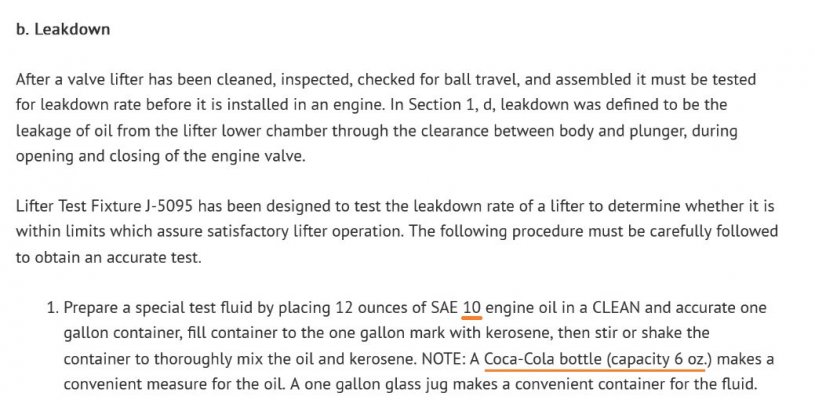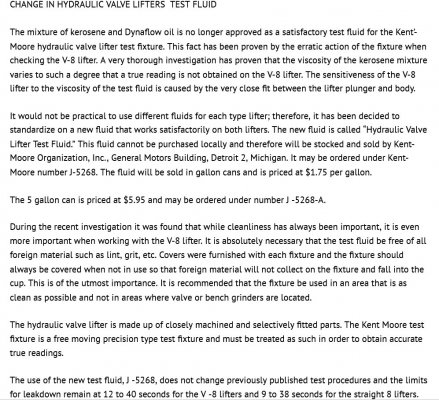I wonder what the "special" oil is. Possibly straight 30w?
According to the '51 Buick FSM it's a lot thinner than that. The mechanic is instructed
to get an exact 1 gallon container, (preferably glass) add 12oz of 10-weight oil, and
fill up the remainder of the container with kerosene. (I love the common sense directions
in the old manuals -- they state that a 6 oz Coca-Cola bottle is a convenient measurement. :0)
In other words, 12 oz of 10-weight oil + 116 oz of kerosene. (See attached.)
****
That's the short answer. In '54 there was Buick Service Bulletin about a new test fluid that
should be used for hydraulic lifter leakdown testing. (Kent-Moore J-5268) FWIW I've scraped the
interwebs, and I can't find any recent links to this fluid. But I've attached a screen grab of that
service bulletin, mostly to show just how fussy you have to be in terms of cleanliness in order
to get good go/no-go test results.
Moving forward in time, an elder was talking about a bad batch of noisy hydraulic lifters from
the factory in the (brand F) '67 390 V8s. And that he used the Kent-Moore J-5790 leakdown tester
tool to ferret out the bad ones. The cool thing is that he shared a couple of actual photos of his
test rig:
You must be registered for see images attach
You must be registered for see images attach
And to wrap this up, the '94 GM Unit Repair manual mentioned in reply #86 specifically
refers to the J-5790 tester. And that's pretty much the sum total of what I could find in terms
of calibrated hydraulic lifter leakdown test equipment that used to be used by auto/truck mechanics
in the field. Obviously we are closing in on the end of an era.
NOTE: All this careful analysis & testing in the service areas was pushed to the wayside as labor costs
kept rising and parts prices kept coming down. Good parts were cheap & plentiful, so why waste time on
all this stuff? But times have changed, and some of this style of repair may come back into vogue.
(ie: Keep the original bits working as long as possible.)
As always, food for thought. At least we have a good idea of what they were trying to achieve
during diagnostic testing. All I know is that it doesn't take much dirt, varnish, or wear for these
super close-tolerance devices to start drawing attention to themselves in a ticky/clattery way.
FWIW --
EDIT: I happened to find a .pdf of an old J-5790 brochure. Pretty cool - I enjoy old technical
features & benefits artifacts like this. Anything that helps me better understand the mindset
of the folks who were involved with this all-but-forgotten test apparatus.





